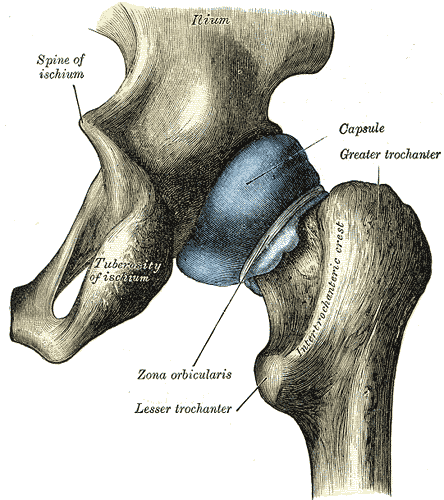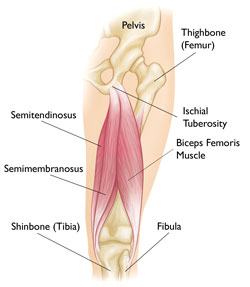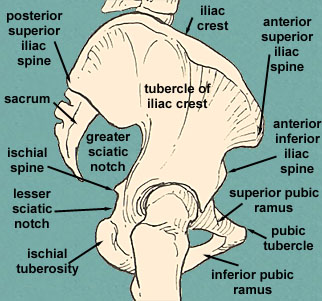Have you ever been through a pain in your buttocks because of sitting at a place for a long time? If yes, it is the tuberosity in your pelvis that is affected. These are also referred to as sit bones or seat bones as they absorb the weight of your body while you’re in your seating position.
When you’re sitting for a long time, it leads to the irritation or inflammation of the ischial bursa. It is a sac filled with fluid present between the ischial tuberosity and the tendons, connecting the hamstring muscle to bone. When the inflammation gets serious, it is called ischial bursitis.
Ischial tuberosity Definition
It is a large bony projection at the junction of the lower end of the body of the left and right ischium, the lower back part of the hip bone, and its ramus. It is also known by several other names like:
- Tuber ischiadicum
- Tuberosity of the ischium
- Sitting bone
- Sitz bone
Ischial tuberosity Location
Specifically, it is situated near the lateral boundary of the pelvic outlet, the space enclosing the lower circumference of the lesser pelvis.
Ischial tuberosity Anatomy
The gluteus maximus, which is the broad, thick, outermost muscle of the buttocks, involved in the rotation and extension of the thigh, covers the bony growth when standing. However, the superficial muscle shifts behind it when an individual sits. The swollen structure mainly comprises of the following:
Lower portion: It is rough and triangular in shape. A longitudinal ridge that passes from base to apex further divides it into two parts.
The outer part offers attachment to the adductor magnus while the inner part provides attachment to the sacrotunerous ligament.
Upper portion: This represents an upper, smooth, quadrilateral region, which is subdivided into two sections, by an oblique ridge, running downward and outward.
The semimembranosus arises from the outer and upper area while the semitendinosus and the long head of the biceps femorise begin from the inner and lower parts.
Surrounding Structures
There are multiple associated structures that provide support to ischial tuberosity. Some of these include Gluteus maximus, hamstrings, abductor magnus, sacrotuberous ligament.
Ischial tuberosity Function
The location of the bony swelling enables it to bear the weight of the body in a seated position. It is a potential site of attachment for several muscles and ligaments such as:
- Adductor magnus: It is a large triangular muscle, situated on the medial side of the thigh that adducts the leg at the hip. It is also responsible for the lateral and internal rotation of the upper leg.
- Sacrotuberous ligament: It is situated at the lower and back part of the pelvis. Its function is to anchor the sacrum to the hip bones to prevent tilting.
- Semimembranosus muscle: It is the most medial of the three hamstring muscles in the back of the thigh. It helps to extend the hip joint and bend the knee joint.
- Biceps femoris: It is a muscle of the posterior thigh that extends the hind limb when propelling, rearing or kicking.
- Semitendinosus: The muscle is located in the back of the thigh. Its function is similar to semimembranosus muscle.
Clinical Significance
Ischial tuberosity is the location where Pudendal anaesthesia is given. It is a local anaesthesia that is given to a pregnant woman during childbirth to make sure she undergoes considerably lesser pain during delivery.
Ischial tuberosity Pain
Ischial bursitis is a common condition affecting a wide range of athletes, in which the fluid-filled bursa lying over the bony growth undergoes severe inflammation and causes pain. An avulsion fracture of the sitting bone occurs when the ligaments holding the hamstrings to the hips tears and break off a piece of the hip bone in the process. Overuse of the tuberosity of the ischium can damage the hamstring muscles, resulting in tendonitis. In some cases, repetitive activities can cause inflammation of the apophysis of the bony swelling that leads to apophysitis. Various treatment methods are available to alleviate the acute pain syndrome, including surgery, cortisone injections, non-steroidal drugs, and rehabilitative exercises to help restore strength as well as stability.
Ischial tuberosity Causes
- Athletes suffer from the pain due to extended overload and strain on the leg muscles as well as the sacrotuberous ligaments
- The pain may occur in the lower region of the buttock because of running or brisk walking
- Swelling and pressure at the location may lead to the pain
- Other causes may include injuries in the area, including
- Fractional tear of the hamstring muscle
- Bruise development at the site where the hamstring attaches
- Tendonitis in the region were hamstring muscle originates
Ischial tuberosity Symptoms
- Pain in the butt is the most common sign of the Ischial Tuberosity pain.
- It gets worsened with long hours of sitting or running
- The site becomes tender, swollen, and sensitive to touch
Ischial tuberosity Treatment
- Take rest but not for a long time as the prolonged resting lead to the reduced blood supply to the damaged tissues, which delays healing
- Exercise and physiotherapy help in the controlling and reduction of the pain. It offers a temporary relief but it cannot be a permanent solution.
- I.C.E. Technique includes rest, ice, compression, and elevation to reduce pain.
- Analgesic Medicines are used for pain relief but not for the cure of the damaged tissues. Some common medicines prescribed are Non-Steroidal Anti-Inflammatory Drugs (NSAIDs), which include aspirin, diclofenac, etc. and COX – 2 inhibitors that include etoricoxib, and celecoxib.
- Prolotherapy is an advanced treatment in which a dextrose solution is injected in the region of pain to treat the damaged tissues. The process allows an increase in the flow of fluid to those tissues, thereby producing inflammation that further helps in enhanced blood circulation. The treatment also helps in the deposition of new collagen, thereby repairing the injured joint ligaments.
- Stem Cell Theory is an innovative method of treating the pain. In this process, the affected ligaments undergo inflammation that boosts self-restoration of the affected tissues, lowering the pain. It uses regenerative cells of the patient for healing the affected tissues. Hence, it considered as a natural process of treating the ischial tuberosity pain.
- Platelet Rich Plasma Technique is yet another treatment that can be used for relieving you from the pain. It is an assisting therapy in which a large amount of cytokinin present in the Platelet Rich Plasma that reinforces and enables the coordination of the physical involvement for healing the soft tissues and bones damaged.
Now when you know the symptoms, causes, and types of treatment to be used to get relief from ischial tuberosity pain, you must visit a doctor who will further assist you in choosing the best treatment method based on the cause of the problem.
Pictures
References
http://en.wikipedia.org/wiki/
http://www.wisegeek.org/what-
http://www.innerbody.com/
http://www.gla.ac.uk/ibls/US/




No comments yet.